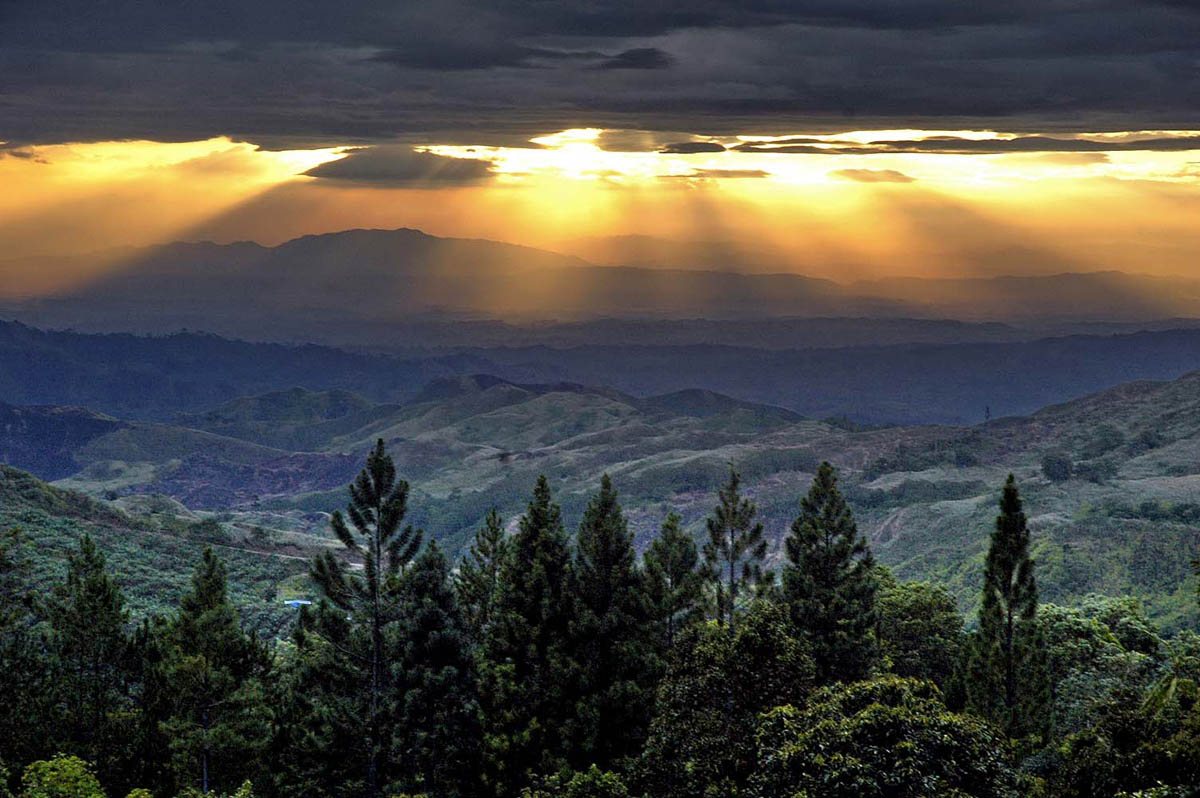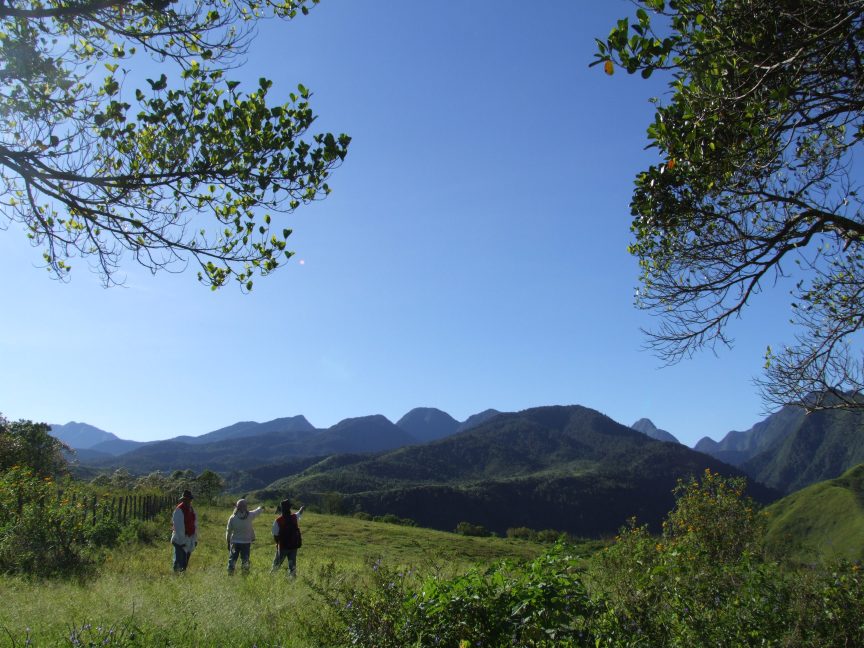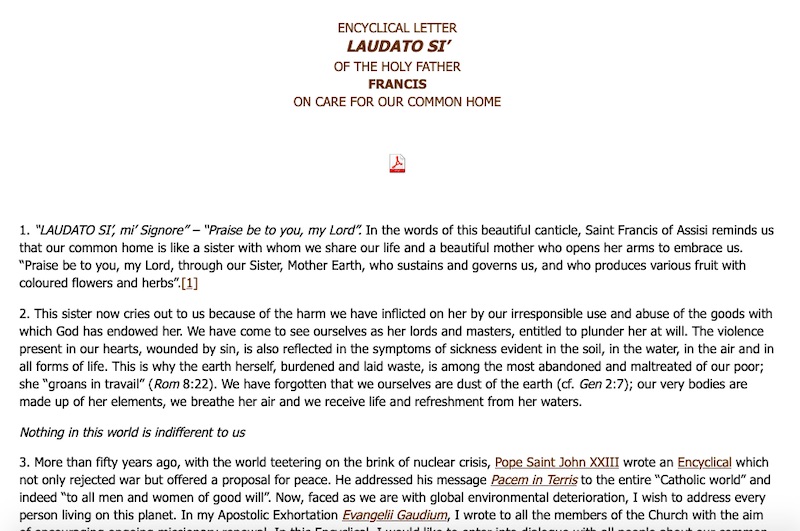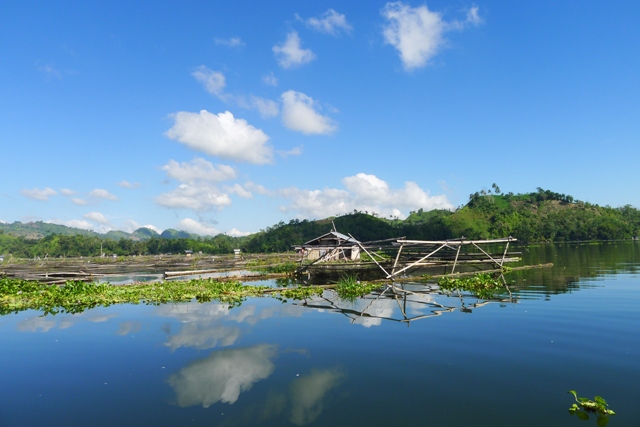CAGAYAN DE ORO CITY (MindaNews / 26 May) — I am one of those who joyfully welcomed the most awaited encyclical of Pope Francis, Laudato Si’ (LS), when it was released on May 24, 2015. To mark its fifth anniversary, the world celebrates the Laudato Si’ Week (May 16-24) with the theme: “everything is connected.” It is actually the recurring ecological view in Laudato Si’.
The church teaching that “all creatures are connected” and “dependent on one another” (LS 42) is not totally new. In fact, as early as 1992, the Catechism of the Catholic Church (CCC) explicitly teaches that “creatures exist only in dependence on each other, to complete each other, in the service of each other” (#340). Building on this God-given interconnectedness, Laudato Si’s appropriation of “integral ecology” seeks to overcome the prevailing tendency to separate the social from the ecological concerns, and vice versa. As Pope Francis explains, “we are faced not with two separate crises, one environmental and the other social, but rather with one complex crisis which is both social and environmental” (LS 139). Let me concretize the meaning of this holistic assertion in Mindanao context.
Mindanao’s Indirect Contribution to Laudato Si’
The Christian option to listen both to the cry of the poor and the cry of the earth is not new to the history of Mindanao Church. It can be recalled that, as early as 1988, the Catholic Bishops’ Conference of the Philippines (CBCP) decidedly issued its first pastoral letter on ecology, “What is Happening to Our Beautiful Land?”

As highlighted in this document, thirty-two years ago “the people of San Fernando, Bukidnon and Midsalip, Zamboanga del Sur defended what remains of their forest with their own bodies. At the Santa Cruz Mission in South Cotabato, serious efforts were underway to reforest bald hills and develop ecologically sound ways of farming. The diocese of Pagadian had chosen the eucharist and ecology as its pastoral focus for this year.”[1] Arguably, this ecological narrative of Mindanao experience must have indirectly contributed to the emergence of Laudato Si’, as the said CBCP document is quoted in the 41st paragraph of the encyclical.
If I may be allowed to commemorate Mindanao’s humble contribution to Laudato Si more concretely personal, let me highlight the significant moments of the environmental activism of the Diocese of Malaybalay, which significantly influenced my seminary formation and priestly ministry. These living memories of my home diocese impelled me to be always on the alert to listen not only to the cry of the poor but also to the groaning of creation.
My home-grown ecological consciousness was gradually awakened during my seminary formation which exposed me to at least three big events of environmental activism. The first big event happened in July 1987 when, as a pre-college seminarian in Malaybalay, some 3,000 residents of the municipality of San Fernando, Bukidnon, opted to hold a series of pickets against logging operations, which greedily exploited the dwindling forests. Eventually, this parish-based environmental protest grew into a diocesan advocacy, which successfully pressured the government to put the whole province of Bukidnon under a logging moratorium in 1990.
The second occurred towards the final year of my college seminary formation when one of our diocesan priests, Nery Lito Satur, was brutally killed on October 14, 1991 due to his zealous implementation of the logging moratorium order. Contrary to the expectation of his killers, this shocking event inflamed the people’s commitment to care for God’s creation and served as an important watershed for their ongoing ecological struggle.

The third took place in November 1999, a few months before my ordination to the priesthood, when a coalition of civil society groups strategically formed a series of human barricades, which successfully blocked the logging trucks from an adjacent province (Lanao del Sur) passing along the highways of Bukidnon.
With hindsight, I realize that all these events have crucially shaped my vocation and pushed me to understand my priestly ministry towards a particular direction: to be a padre cura (i.e., a priest who cares) for the poor and the earth. These events also made me realize that priests are called to care not only for the community of human persons (cura personalis) but also for the larger Earth community (cura terrae). In many ways, this insight anticipates some important elements of Laudato Si’s integral ecological perspective.
Mindanao Experience Vindicated by Laudato Si’
The foregoing ecological narrative serves as pre-history of Laudato Si’ in the sense that it anticipates Pope Francis’ call “to hear both the cry of the earth and the cry of the poor” (LS 49).
The Pope makes it clear that the term “poor” does not only refer to the oppressed human being but also to “the earth herself, burdened and laid waste… [making her] among the most abandoned and maltreated of our poor” (LS 2). In this sense, to care for the oppressed people cannot be separated from the care for the exploited Mother Earth. As the encyclical puts it, “the deterioration of the environment and of society affects the most vulnerable people on the planet” (LS 48). In this light, both the cry of the poor and the cry of the Earth are two sides of the same coin.
 Along this line, the Brazilian liberation theologian Leonardo Boff published a book (Cry of the Earth, Cry of the Poor) in 1995, twenty years before the release of Laudato Si’. It has been proposed that the Holy Father creatively appropriated Boff’s expression to emphasize the integral ecological view of Laudato Si’. My deep familiarity with Boff’s writings affirms this and has predisposed me to understand Laudato Si’.
Along this line, the Brazilian liberation theologian Leonardo Boff published a book (Cry of the Earth, Cry of the Poor) in 1995, twenty years before the release of Laudato Si’. It has been proposed that the Holy Father creatively appropriated Boff’s expression to emphasize the integral ecological view of Laudato Si’. My deep familiarity with Boff’s writings affirms this and has predisposed me to understand Laudato Si’.
Let me briefly point out three important insights from Boff that may have influenced the integral ecology of Laudato Si’. First is Boff’s contention that our preferential option for the poor has to embrace “all the poor with all their many faces, and the great poor one, the Earth”[2] (cf. LS 2). Second is his proposal that our concern for ecology is a social imperative “since the decline in the quality of their surroundings produces social tensions, violence, disease, malnutrition and even death.”[3] And third is his affirmation of the causal connection between poverty and exploitative ecological practices (cf. LS 92, 196). For Boff, both negative realities systematically stem from the same logic of oppression used by the proponents of unlimited growth.
The Challenge to Sustain Our Ecological Advocacy
Five years after Laudato Si’, it is also good to ask whether or not the fire of environmental activism that was burning in Mindanao 32 years ago still continues today. Are the people of San Fernando, Bukidnon and Midsalip, Zamboanga del Sur able to defend what remains of their forest? What happened to that serious efforts at Santa Cruz Mission in South Cotabato to reforest bald hills and develop ecologically sound ways of farming?

quarters have also been blamed for the pollution of Lake Sebu.
MindaNews file photo by Bong S. Sarmiento
It is exciting to hear an honest answer to these questions. As of now, however, I can only partially speak of my home diocese—the Diocese of Malaybalay. In 2019, there was a diocese-wide renewal seminar led by the Redemptorist mission team to prepare the Diocese for its golden jubilee celebration in 2020. Bro. Karl Gaspar, one of the facilitators of the General Mission, critically observed: “I discovered as I was going around the different parishes that there seems to be a weakening of the BECs concern for ecological issues. It is even possible that there are many young people—including students of our Catholic schools—who have never heard of Fr. Neri Satur.”
Gaspar’s observation was validated in the same year when a random survey was conducted on the 14 parishes of the Diocese regarding their respective ecological practices. The survey reveals that 57% of these parishes have no ecological desk; 29% of them never conducted catechesis about care for the Earth; and about 43% never conducted training(s)/lecture(s) on Laudato Si’. Thanks to these empirical data that serve as a strong challenge of the Diocese of Malaybalay to rekindle its ecological advocacy especially at this moment of climate emergency.
I am sure that the Diocese of Malaybalay is not alone in the struggle to maintain a strong ecological advocacy. I realized that this is the common struggle of the Philippine Church when I participated in the National Convention on Laudato Si’ and Climate Emergency held at Layforce, San Carlos Seminary, Guadalupe (Makati) on September 3-5, 2019. In their Statement of Unity, the participants “highlight the extreme importance of strengthening the ecology desks of the respective dioceses by providing them with competent personnel who have preferential option both for the poor and for the earth. … [They] strongly call on the respective diocesan bishops and religious superiors to prioritize the allocation of budget and financial support for the ecology desk.”
As of now, the top-down approach still prevails in the church. For this reason, the success of appropriating Laudato Si’ extremely depends on the bishops’ and clergy’s reception of it. Without clergy’s support (especially parish priests), I believe that it will just be ignored. Let the priests and religious be its prime agents and leading implementors by bringing it down to the parish and BEC levels.
(MindaViews is the opinion section of MindaNews. Reynaldo D. Raluto is a Roman Catholic priest of the Diocese of Malaybalay. He is the Academic Dean of St. John Vianney Theological Seminary in Cagayan de Oro where he also teaches fundamental/systematic theology and Catholic social teaching. He is the author of Poverty and Ecology at the Crossroads: An Ecological Theology of Liberation in the Philippine Context (Quezon City: Ateneo de Manila University Press, 2015). His ecological advocacy includes planting/growing Philippine native trees, mountain climbing, and defending the rights of Indigenous Peoples.]
[1] CBCP, “What is Happening to Our Beautiful Land?” (Tagaytay, January 29, 1988); printed in Sean McDonagh, The Greening of the Church (Quezon City: Claretian Publications, 1990), 207-216, on 212.
[2] Leonardo Boff, “El pobre, la nueva cosmologia y la liberación: Cómo enriquecer la Teologia de la Liberación,” in Alternativas 18/19 (2001): 75-89, on 86.
[3] Leonardo Boff and Virgil Elizondo, “Ecology and Poverty: Cry of the Earth, Cry of the Poor,” in Concilium (1995/5), ix-xii, x; see Leonardo Boff, Cry of the Earth, Cry of the Poor, translated by Phillip Berryman (New York: Orbis Books, 1995/1997), 107.







